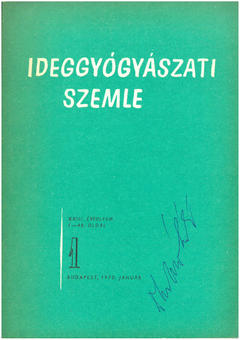The eLitMed.hu medical portal uses computer cookies for convenient operation. Detailed information can be found in the Cookie-policy.
Clinical Neuroscience - 1970;23(1)
Content
[Greetings to Imre Hermann]
[Hungarian psychiatrists and psychologists salute Imre Hermann, who is 80 years old, and who can learn the most from his rich life's work of observations and reflections. His name as a psychoanalyst is known worldwide. The significance of his work extends beyond the problem of psychoanalysis; it provides useful results and fruitful ideas for experimental psychology, psychology of thought, psychopathology, cultural and social psychology.]
[Electrophysiological study of experimental brain tumours]
[In the experiments known from the electrophysiological literature, intracranial constriction was induced mainly by mechanical means [2, 3, 5, 13], which was both much faster and differed in many parameters from oncological events. Experiments with transplanted tumors in large laboratory animals (rabbits, dogs, cats) are rare [ 4]. Our present experiments seem to be suitable to monitor a wide range of cerebral electrical phenomena in experimental tumor growth from normality to exit.]
[Using the Hamilton Depression Scale]
[The author briefly outlines the importance of quantitative psychiatric symptom assessment, and then describes the validity and reliability tests of the Hamilton depression scale in Hungarian settings, as well as its mean scores.]
[Data on the socio-psychological and epidemiological aspects of alcoholism]
[Our paper is the third and final part of our exploratory studies, which attempted to explore the main issues of alcoholism from a socio-psychological and sociological perspective. First, we addressed the group-psychological interactions that can modify, or even extinguish, or even replace the effectiveness of drug treatment attempts aimed at setting abstinence [13]. Then, we analysed epidemiological data on 4241 male patients to explore the mode of transmission, direction and causes of alcoholism (as a public health problem), which is endemic in our country [15]. This time we do the same for 621 female patients who were treated in the women's psychiatric wards of the metropolitan hospitals at the same time as the 4241 male patients, i.e. in the same two three- to three-year periods, ten years apart.]
[Infusion therapy of delirious states in elderly arteriosclerotic patients]
[He reports on his experience with infusion therapy of delirious states in elderly arteriosclerotic patients. In addition to the good therapeutic results observed in practice, he has also determined the circulating blood volume in some cases. In agreement with the literature, he observed a marked decrease in circulating blood volume in these conditions and attributes an important role to this in the development of delirious states. He considers the determination of circulating blood volume by the isotope method to be of considerable help in both diagnosis and therapy.]
[Impact of severe early infantile atrophy on psychosomatic development]
[Authors conducted follow-up studies in school-age children: young infant survivors of severe atrophy (29 cases) and an adaequate control group (29 cases). In 80% of the former atrophy patients, weight loss at the nadir of atrophy was greater than 20%. At school-age follow-up, their length and weight development was identical to that of their peers. Neurological examination found an accumulation of pathological neurological findings compared to the control group (34.4%: 10.3%). Psychological examination showed no difference in the distribution of I.Q., but a striking prevalence of speech disorder, a high number of individuals with "encephalopathy" showing abnormal personality development (66.6%: 35%) in the former atrophied group. In view of the above, follow-up care and monitoring of the stunted infants, and adjustments to the family and school environment seem desirable.]
[Regional brain perfusion in tumor patients using intra-arterial Xenon-133 clearance methodology]
[Author investigated regional brain perfusion in tumour patients using intra-arterial Xenon-133 clearance methodology. Non-tumoural regional blood flow was reduced to subnormal, while relative hyperemia was observed in tumour. Hypercapnia results in a paradoxical decrease in flow in tumour regions ("intracerebral steal"). In hypocapnia, a paradoxical increase in flow in these regions ("intracerebral inverse steal") was observed. The tumour brain loses its autoregulatory capacity mostly diffuse, in which case cerebral flow becomes a passive function of systemic blood pressure. In some regions, an artificially induced increase in blood pressure results in a paradoxical decrease in blood flow, whereas a decrease in blood pressure results in a paradoxical increase in blood flow. The clinical and diagnostic significance of the findings is discussed.]
1.
Clinical Neuroscience
[Headache registry in Szeged: Experiences regarding to migraine patients]2.
Clinical Neuroscience
[The new target population of stroke awareness campaign: Kindergarten students ]3.
Clinical Neuroscience
Is there any difference in mortality rates of atrial fibrillation detected before or after ischemic stroke?4.
Clinical Neuroscience
Factors influencing the level of stigma in Parkinson’s disease in western Turkey5.
Clinical Neuroscience
[The effects of demographic and clinical factors on the severity of poststroke aphasia]1.
2.
Clinical Oncology
[Pancreatic cancer: ESMO Clinical Practice Guideline for diagnosis, treatment and follow-up]3.
Clinical Oncology
[Pharmacovigilance landscape – Lessons from the past and opportunities for future]4.
5.



